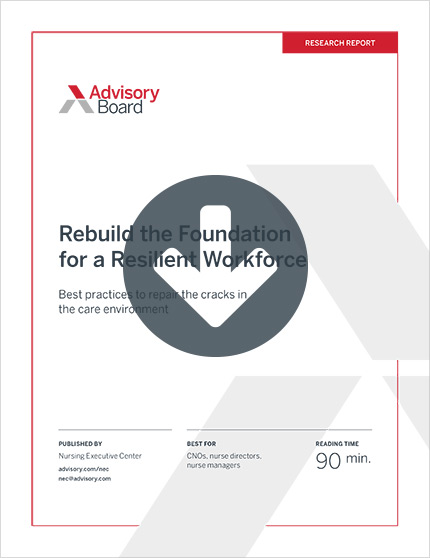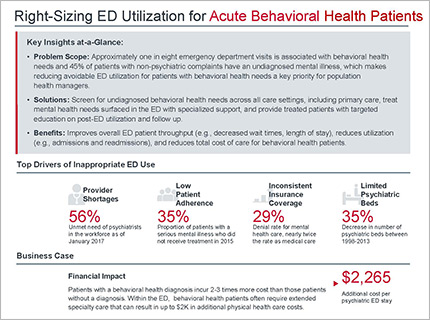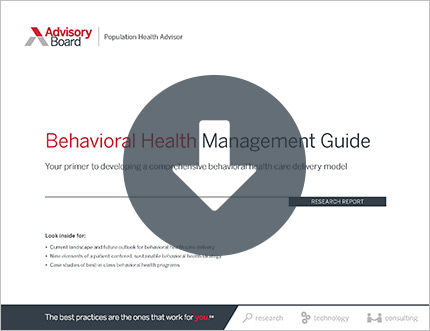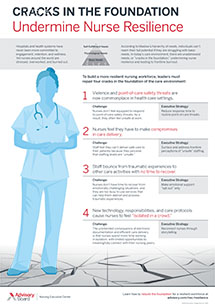Auto logout in seconds.
Continue LogoutEditor's note: This popular story from the Daily Briefing's archives was republished on Nov. 21, 2019.
Episodes of violence are becoming more common and more severe in U.S. emergency departments (EDs), prompting ED clinicians to push for tighter security as well as policies to protect clinicians who are in harm's way, Arthur Allen, Victoria Colliver, and Dan Goldberg report for Politico.
Infographic: The 4 foundational cracks that are undermining your nurses’ resilience
Violence against ED workers is increasing
In interviews with about 24 ED physicians, nurses, and senior hospital officials from several states—including Alabama, Alaska, California, Massachusetts, New Mexico, New York, and Oregon—Politico found hospital employees "shared the perception that the incidence and intensity of violence is increasing in" U.S. EDs.
Jon Sendach—deputy executive director at North Shore University Hospital, which is part of Northwell Health—said patients and their family members have become more aggressive over the years. "You didn't hear, with the same frequency, statements like, 'I'm going to kill you,' or, 'I have a gun at home I'm going to kill you,'" Sendach said. He added, "There seems to be a change in people's willingness to make threats. … Either people are dissatisfied with the treatment plan, or, in some cases, people are delusional."
While the federal government does not maintain specific data on violence in EDs, data from the Bureau of Labor Statistics show the rate of attacks against registered nurses (RNs) in hospitals increased more than twofold from 2008 to 2016. Lisa Wolf, director of the Institute for Emergency Nursing Research in Des Plaines, Illinois, said the figures could be extrapolated to ED nurses.
Separately, a 2016 report from the Government Accountability Office showed the prevalence of nonfatal violence against U.S. health care workers was at least five times higher than among the rest of the U.S. workforce.
Anne Zink, a physician at the Mat-Su Regional Medical Center in Palmer, Alaska, said, "I got a black eye in a psych room when a patient pushed me against the wall and punched me repeatedly." She added, "We had a nurse almost strangled with IV tubing. Another nurse got bitten."
What's driving the increase?
U.S. EDs serve as a "door into the underside of American life," according to Politico. As such, Politico reports the rise in violence at EDs "speaks to the nation's unresolved health care ills," such as the opioid epidemic and increasing out-of-pocket costs for medical care, Politico reports.
According to Politico, efforts to address the opioid epidemic by cracking down on opioid prescriptions—which fell by nearly a third in the United States since reaching a peak in 2011—are one factor behind the rise in ED violence. Patients who wake up after being treated for an overdose and patients who are refused opioids after being identified as engaging in "doctor shopping" often become agitated and aggressive, Politico reports.
Employees at Northwell, the largest health care system in New York, for instance, reported more cases of aggression after the health system tightened restrictions on opioid prescribing. Adrienne Drohomirecky, director of employee safety and prevention at Northwell, said patients who had been able to go from one hospital to another in search of opioids became frustrated when Northwell staff told them they could not have opioids.
Unmet demand for mental health care is another factor behind increasing violence in EDs, Politico reports. Stephen Anderson, a critical care physician with more than 30 years of experience in Auburn, Washington, said, "Mental health problems have gotten worse, and the answer is, 'Send them to the ED.'"
Separately, Zink, former president of the American College of Emergency Physicians (ACEP) branch in Alaska, said an increase in tensions over health care copayments and deductibles have spurred an increase in violence in EDs as well.
"It used to be a $50 decision to come to the E[D]. Now it's a $5,000 decision," Zink said. "You do a CAT scan of someone's belly and say, 'I can't see anything wrong, follow up with your primary physician.' And they say, 'I'm going bankrupt because I came in here. What do you mean nothing's wrong?'" Zink noted that over the years "public discourse has changed" as well.
Others have said "the tumult of often crowded" EDs is partly responsible for the violence in U.S. EDs, Politico reports. Wolf said, "We've found that the environment of the ED—how chaotic it is, with patients feeling no one's paying attention, drives people to act out. They feel unheard and unattended to, and if you have a proclivity to going off the deep end, that's the environment where you're going to do it."
What hospitals and lawmakers are doing about it
Unable to resolve the underlying issues prompting the rise in violence, federal and state lawmakers and ED employees in recent years have urged hospitals to strengthen their security. As result, hospitals in 2016 spent $1.1 billion to bolster their security in addition to spending $439 million on insurance, medical care, staffing, and other costs related to violence against hospital employees, Politico reports.
In addition, ACEP in 2017 passed a resolution that called on hospitals to confront workplace violence. Meanwhile, a state law in California began requiring that hospitals report all incidents against employees to the state occupational safety regulators as of July 2017. California's law requires that hospitals create unit-specific plans to identify and handle risks related to violent incidents, including "everything from training employees to ensuring proper lighting and using panic or security alarms," Politico reports.
Further, 31 states have laws that make it a felony to assault an emergency nurse, according to the Emergency Nursing Association.
At the federal level, Reps. Ro Khanna (D-Calif.) and Mike Coffman (R-Colo.) in March introduced a national bill modeled after the California law, which would make reporting requirements and violence prevention plans a national standard.
But will these efforts by enough?
However, many observers have said increasing security is not enough to stem the rise in violence, Politico reports. "[E]ruptions of violence will continue" if there is no "concerted response to address the underlying mental health care issues, drug treatment, and other problems" driving the increase in violence, according to Politico.
Anderson said, "I think the U.S. is just more violent than it was 3 years ago or 30 years ago. The country's a little nervous for a lot of reasons. And we're not soothing society's concern" (Allen et al., Politico, 7/7).
The 4 foundational cracks that are undermining your nurses’ resilience
Check out our infographic to learn which four cracks in the care environment leaders must repair to rebuild the foundation for a resilient workforce.
Don't miss out on the latest Advisory Board insights
Create your free account to access 1 resource, including the latest research and webinars.
Want access without creating an account?
You have 1 free members-only resource remaining this month.
1 free members-only resources remaining
1 free members-only resources remaining
You've reached your limit of free insights
Become a member to access all of Advisory Board's resources, events, and experts
Never miss out on the latest innovative health care content tailored to you.
Benefits include:
You've reached your limit of free insights
Become a member to access all of Advisory Board's resources, events, and experts
Never miss out on the latest innovative health care content tailored to you.
Benefits include:
This content is available through your Curated Research partnership with Advisory Board. Click on ‘view this resource’ to read the full piece
Email ask@advisory.com to learn more
Click on ‘Become a Member’ to learn about the benefits of a Full-Access partnership with Advisory Board
Never miss out on the latest innovative health care content tailored to you.
Benefits Include:
This is for members only. Learn more.
Click on ‘Become a Member’ to learn about the benefits of a Full-Access partnership with Advisory Board
Never miss out on the latest innovative health care content tailored to you.




